Game development is a wonderful and enjoyable pastime, from the thrill of getting the creative juices flowing, through writing ideas down on paper, to seeing those ideas go from paper to the screen and into a game engine. Finally, seeing the product spread throughout the world and achieving fame for the game is a feeling like no other. Many people, however, do not consider what is involved in creating a game. The first step is planning your game, writing up documentation describing it, drawing up levels, and more. Having your game planned before you start developing improves the fluidity of creation. Believe me, a retail game on a console did not just happen, a developer wasn't sitting at his computer and started creating, no! Creative teams designed the game in all its details. Mind you, you do not have to go into such detail, but writing down a rough idea will surely ease your game's development. It can also be a lot of fun designing your game; once you get started, the ideas will come very quickly and you'll be on a roll. It doesn't matter where in your design document you start, it can be a simple character sketch, or a really cool level design; once you get started, it will all come together. Let me demonstrate how easy it is. Let's say, for example, your main character's name is Maximus, the son of a Roman Centurion. One night, his father leaves the house to get him a meal. Hours later, he has not returned. Maximus ventures forth, and soon finds out that his father was captured by the evil Druid Seraphix. Now things are coming together aren't they? See from there, now you have a baseline, you know what your player has to do, and filling in the details will come easily. Let's say, your first mission is to enter into Druid's hideout to save your father, but before you enter the dungeon the Druid finds you, and sends you to a faraway land. Now, you have to fight your way back to the hideout. As you do, you get stronger and better equipment. See, it's easy!
In this chapter, we are going to consider the following:
- How to come up with an original idea for a game
- Design documents (what your character will do, who he will fight, and so on)
- Creating Storyboards and Levels
Make sure you have some time, some peace, and a quiet environment, so you can think, and if necessary, an extra-large coffee or latte from your favorite cafe.
First, let's see how to come up with an original idea.
Today, there are literally millions of games available, from gaming consoles to mobile platforms. They range from realistic simulation racing games, to story-driven role-playing games. With so many games out there, you might think that coming up with an original idea would be difficult, and it can be. Simple games are often the most fun (and highest-grossing) for mobile platforms. Take for example, one of the highest-grossing iOS game, Angry Birds. The game is not complex, the story is quite simple and yet it has hit it big. Why? It's a simple game, with easy addictive gameplay, a game that will keep the user coming back to play it. It's one of those games that when someone downloads, they will go to their friends and say, "Hey have you seen this game? It's so addictive!"
Your idea may not be 100 percent original, but you can make it unique. Games that take place after the apocalypse or where you have to save the world by killing countless aliens hordes are a dime a dozen. And as fun as these games can be, they lack originality. The key to creating an original idea is to do your research, look at the store shelves and see the same genre over and over again, then break the mould, be original my friend! You can even mix and match certain game elements from different genres, first person shooter + puzzle = Portal, RPG + Third Person Shooter = Mass Effect. These are all ingenious ideas, and games that were very successful.
Another good piece of advice is to look around, look at your surroundings. See any good game ideas? Are you near a lake? How about a scuba diver game? Or a submarine game? Have you ever had a bat or a bird enter your house? Play a garbage man collecting garbage being thrown from buildings. The original ideas are endless, and are usually right in front of your face. Also, you can look at classic games—released many years ago—that have been long forgotten, on the Atari, NES, Commodore 64, and so on. Original ideas that have been forgotten are endless.
Ok, so now you have your idea all ready, it's time to get it all on paper, or if you like on your computer. What's included in the design documentation? Simply, everything! What is the name of your character? What will he do? What will he look like? Who will he fight? What weapons or items will he use? And so on.
Following is an example of a design document:

Get the idea? This level of detail is not needed for your game, unless you absolutely want to. Let's get a stripped down, easier to use, less headache-inducing template, shall we?
- Name of your game
- Features (What would you like in your game, Game Center, leaderboards, and so on)
- Story of your game
- Look and feel (Describe an art style you would like for your game, that is, dark, gritty, cartoon, and so on)
- Targeted number of levels
- Weapon types (If designing a shooting or an action game)
- Game progression (How the game is going to play out, for example, what will happen to your character once he finds the hidden scepter? How will the storyline change?)
- Objectives of the game (Things your player will have to complete to beat the game)
- Movement (How will your player move, 2D side-scroller? Bird's eye view?)
- Objects (What will your player collect? Coins for points? Hearts for health? Glowing orbs for ammo?)
- Player characteristics (What's his name? What can he do? What special abilities does he have or will he gain? What's his story? Where will he go after your game?)
- Hidden game features (What will you hide in the game as easter eggs, if any)
- Combat (How will players fight? Shooting? Hand to hand? Death by Tofu?)
- Main menu design (What is your menu screen going to look like? Background image? Buttons? Copyright information?)
- Game controls (Onscreen buttons or joysticks? Accelerometer movement?)
- NPCs (Important Non-Player Characters that will be seen in the game)
- Enemy's characteristics (self-explanatory, but how can they be defeated? How can you be hurt by them?)
- Game HUD (The overall look of the in-game heads up display, what will it show? Score? Health? Ammo?)
That's easier now, isn't it? Including this information will certainly ease development, as knowing everything when you get into the game will make designing the characters, levels, and more much quicker. Now that you have the design documentation done, let's get started on the level design, and storyboards.
Storyboards are useful for in-game cutscenes. Storyboards are graphic organizers such as a series of images displayed in sequence for the purpose of pre-visualizing a cut scene. This process was invented by Walt Disney in the 1930s, and has been adopted by animation studios around the world. Following is an example of what a storyboard for a game looks like:
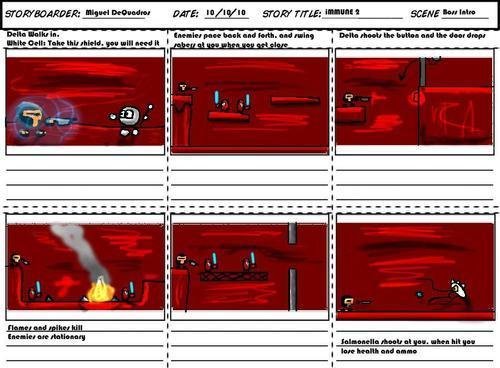
Now that you have an idea of what a storyboard looks like, you can create your own. You do not need to create one if you aren't doing any cutscenes in your game, though they can help with level design too.
Take a look at the resources section of this book; you will find a download link for the empty storyboard template.
Tip
Downloading the support files
You can download the example files for all Packt books you have purchased from your account at http://www.packtpub.com. The colored images for this book can be downloaded from http://www.packtpub.com/sites/default/files/downloads/2205_Images.pdf. If you purchased this book elsewhere, you can visit http://www.packtpub.com/support and register to have the files e-mailed directly to you.
You can draw a rough sketch of each frame in the boxes, and write a dialogue or any special instruction—such as "Character moves to left past screen"—on the lines.
Level design is also very important for the creation of your game. Designing levels in advance makes it easier to create them within your game engine. When you draw level design templates, they should include every detail, such as locations of collectables, enemies, and so on. A good 2D platformer level is not linear, meaning it's not straightforward. It involves jumping and climbing over obstacles, alternate paths to get across that big chasm preventing you from reaching your goal, and various other challenges; but even if you are creating a table tennis game, or a racing game, it's still a good idea to design your level/scene before you implement it within the game engine Let's take a look at a sample level design sheet for a platform game:
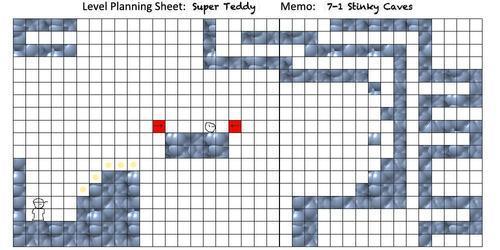
Following is another example of a level design sheet:
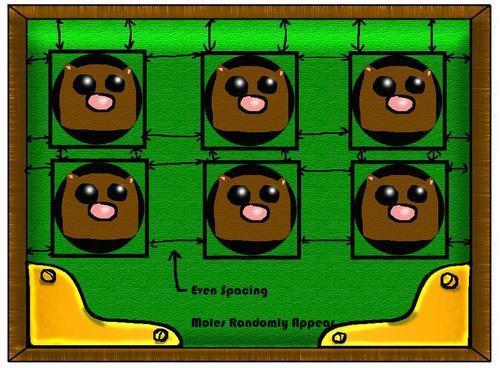
As you can see, this level design sheet can be very handy when it comes to designing a rough copy of your level; it will make development much easier. Once it's all planned, it will take very little time to implement it in your game engine. It can show you where you are going to start your character, where certain collectables are going to be, where your enemies will be, where the invisible collider "walls" will be—so that your enemies won't fall off the platform, and even hidden areas in which you will find secret collectables and hidden ways to get there—such as hidden updrafts that will throw your character up to a secret hole in the wall to collect the special coin.
As with the storyboard template, you can find this template in the resources section of this book. Print out a couple of these pages, and put them in a binder. It's a great idea to have your own special binder specifically for your game design. Being organized is a good idea when planning your game, finding things is so much easier when you don't have to search the pile of papers on your desk.
When you get into it, designing and planning your game can be very much fun, especially when you get on a roll and the creative juices start flowing. It can take minutes, or many days, to think of a good working idea for a game, but once you have that idea and build on it, it can become a design to be proud of and want to show off the finished product.
Do you have your game planned out yet? No? Well that's okay, for the rest of this book the games are designed for you; you just have to put them all together. If you do have your game all planned out, what we are going to consider in this book will help you get started with developing it. It's going to be a wild ride... Want to get a good idea of what we are going to accomplish in this book? Following are a few screenshots just to whet your appetite.
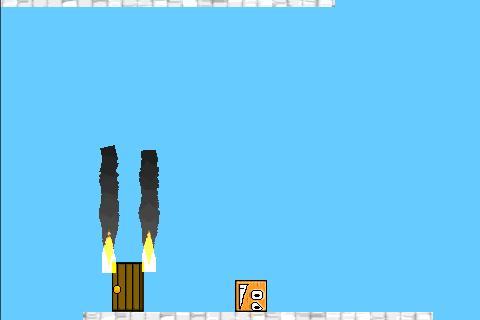
This game is a fun platform game that will teach us about physics, platform movement, and particles.
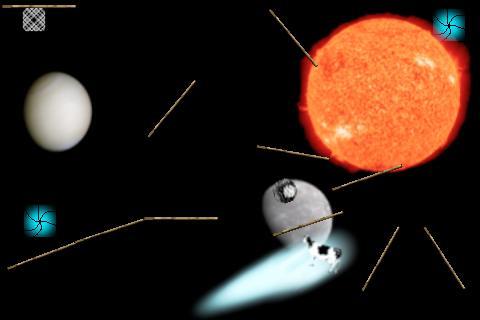
Everything looks pretty cool huh? The following is the last screenshot in this section, it's an asteroid clone that we are going to make!
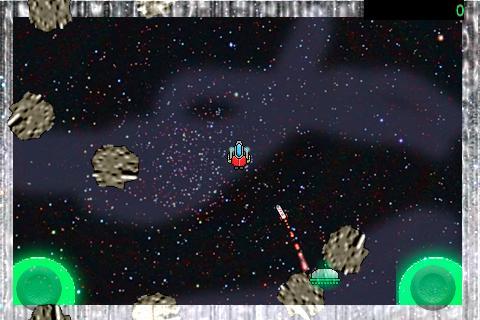
Now, let's have a quiz to see what you have learned.
- What are the top selling mobile games?
a. Shoot 'em ups.
b. Racing games.
c. Simple games with addictive gameplay.
d. None of the above.
- Why is it a good idea to have a design document?
a. It's not.
b. It's good to have in case your idea gets questioned.
c. Helps with publishing your game.
d. Improves the work flow, allowing easy reference.
- Who started using storyboards?
a. Walt Disney.
b. Pixar.
c. Lucasfilm.
d. Warner Brothers.
